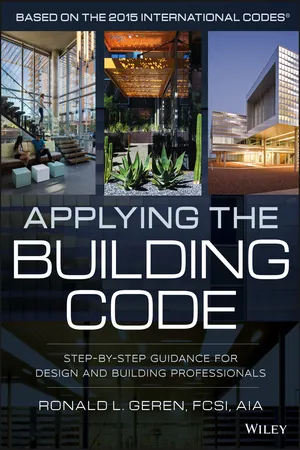
Applying the Building Code
Step-by-Step Guidance for Design and Building Professionals
Ronald L. Geren
- English
- ePUB (mobile friendly)
- Available on iOS & Android
Applying the Building Code
Step-by-Step Guidance for Design and Building Professionals
Ronald L. Geren
About This Book
No other resource—not even the building code—presents the exact code information you need, when you need it at design stage
The International Building Code (IBC) is a model building code developed by the International Code Council (ICC). The IBC and its complementary codes provide design and construction professionals with a complete set of comprehensive, coordinated building safety and fire prevention regulations in order to safeguard the public health and general welfare of the occupants of new and existing buildings and structures. Adopted throughout most of the United States and its territories, it is referenced by federal agencies, such as the General Services Administration, National Park Service, Department of State, U.S. Forest Service, and the Department of Defense. For architects and other design and construction professionals, it is particularly important that they understand how to apply the IBC and how code officials view buildings, so that they integrate code-required provisions in the earliest design stages of any project.
Applying the IBC, as well as its companion codes, to building design is a process that is uniquely different to that of applying the building code during a planning review. Whereas other guide books explain the IBC in sequential order, from cover to cover, chapter by chapter, and section by section, Applying the Building Code explains the requirements of the IBC as they would apply during the common phases of design: from schematic design through to the preparation of construction documents. This effectively highlights applicable requirements of the building code at the appropriate stage of design based on available information.
- The book provides a 28-step process that is organized according to the three phases of architectural design: schematic design, design development, and construction documents
- Each step explains the application of the IBC, as well as other codes and standards referenced by the IBC (i.e. International Fire Code, International Energy Conservation Code, and ANSI A117.1) based on available project information
- Illustrations and examples are provided throughout that explain the code fundamentals associated with each step
- A single example project is used throughout the step-by-step process to illustrate how each step is applied and builds upon code and project information obtained through previous steps
- Guidance is also provided on the International Existing Building Code and how the step-by-step process is applied to projects involving existing buildings
- The role of the building department and its staff in regard to plan reviews and code enforcement is discussed
- A detailed code data information template is provided that can help organize code-related information for construction documents
Frequently asked questions
Information
Table of contents
- Cover
- Title Page
- Copyright
- Table of Contents
- Dedication
- Preface
- Acknowledgments
- Part I: Code Basics
- Part II: Schematic Design
- Part III: Design Development
- Part IV: Construction Documents
- Part V: Existing Buildings
- Part VI: Code Enforcement
- Appendix A: Architectural Program For Privatized Student Housing
- Appendix B: Code Data Information Template
- Appendix C: Code Data Information for Example Project
- References
- Index
- End User License Agreement